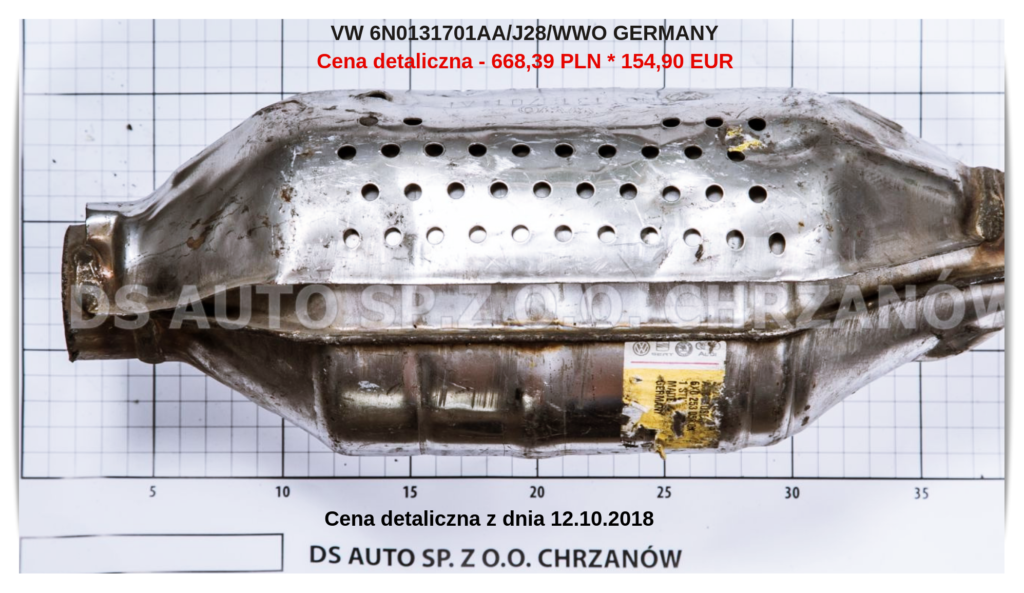Catalyst 6N0131701AA/J28WWO GERMANY is a catalyst used by the Volkswagen brand. It is characterized by small size – it measures about 35 cm in length, although its weight amounts to 1.235 kg. It has a symmetrical, round shape. It is distinguished by a perforated casing. Occurs in the Volkswagen Polo model. A common case of the 6N0131701AA/J28WWO GERMANY catalyst is the falling of the housing. In this situation, it is best to use a specialized collection center. Only an expert is able to correctly recognize this model and value it accordingly.

Volkswagen Polo is produced by the German automotive concern Volkswagen AG. It entered the market already in 1975. Where did the name come from? According to the creators, sports and polo discipline became the inspiration. The first generation of the model was sometimes called the Derby.
How did the history of this iconic city car begin? It turns out that it dates back to 1971, when German engineers received information that it is necessary to create a car with a maximum length (up to 3.5 m), having at the same time a light (not exceeding 700kg) structure.
The car was presented for the first time in 1974, but it was released under the Audi brand as the “Audi 50” model. About 180,000 copies of the 50 were produced.
In 1975, he was presented at the motor show in France. Polo was slightly different from the Audi 50 (which had already been withdrawn back in 1978) with fewer facilities and a lower price, more affordable at the time.
The first generation of Polo was equipped with a four-cylinder 0.9-liter engine and a low 40-horsepower. A year later, the 1.1 engine version, with 50 hp power, was also introduced.
The breakthrough came in 1979, when the car underwent several modifications related to the equipment, and the GT version with a sporty fit entered the market.
The second generation was produced from 1981. It was decided then to extend the car, increase the engine capacity to 1.4, and the next sport version – G40 (116 hp) was released. Polo underwent further modifications, as a result of which they were equipped with new headlights and bumpers. The radiator grille was also added.
The third generation entered the market in 1994. During its production, a floor slab from Seata Ibiza was used. The car was then equipped with two airbags, a sedan version was introduced, a sports version of the GTI (125 HP) was released and the dashboard was modified. In 1996, the production of the model at the Volkswagen factory in Poznań began.

Source: https://www.sekizsilindir.com/2017/06/yeni-eski-vw-polo.html
The fourth generation was released in 2001. The Polo Classic version was introduced, and in 2003 the Fun version. In 2005, the car underwent another face-lifting, as a result of which the car was extended, its height increased, the basic equipment diversified and the design of the entire front was changed. The Cross Polo field version entered the market, and in 2010 it was decided to bring production back to life in South Africa, where the Polo Vivo model comes from.
The fifth generation starts in Geneva, 9 years ago, and a year later Polo Sedan was presented in Russia. Volkswagen was the first to use LED headlights in the city car. Also, interesting facilities were introduced – the Automatic Post-Collision Braking system, whose task was to mitigate the effects of breaks and increase safety during sudden braking. Cruise control and power steering have also been added.
Polo of the fifth generation won the first place in the competition for the European Car of the Year 2010, as well as the first prize in the World Car of the Year.
Currently, from 2017, the sixth generation of Polo is produced. As has been the case with previous generations, headlights and bumpers have been modernized, and the shape of the body has been modified so that the car will take on a more expressive, predatory character.
Where did the Polo worship come from, millions of copies sold and the fact that it is one of the most recognizable models in the world? Its biggest advantages are economy, low maintenance, a wide range of engines and a rust-resistant body. Polo is easy to sell, there are no problems with repairing and finding spare parts, and the interior is described as comfortable and spacious. Often, however, he is accused of monotony and repetitiveness in the modifications made.
The car, despite some minor minuses, is still very popular.

 Phone number:
Phone number:  E-mail:
E-mail:  A stationary point:
A stationary point:  Getting from the customer:
Getting from the customer:  XRF analysis spectrometer:
XRF analysis spectrometer:  Valuation by numbers:
Valuation by numbers: 